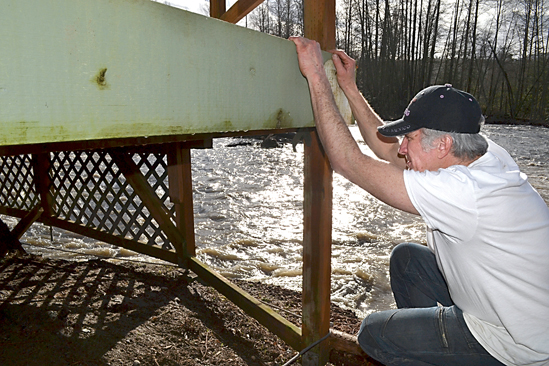SEQUIM — More than a month after taking precautions to save his home, Matt McWilliams said the threat of the Dungeness River is closer than ever.
In December, McWilliams and a friend put logs and debris in the river to deter the current from eroding soil by his home at 131 Serenity Lane, about 2½ miles south of U.S. Highway 101 off River Road.
But a recent storm has put the river back on track toward his home.
“If you want to take your life in your hands, you can walk on the deck,” said McWilliams, 59.
Portions of the deck’s support beams now float above the river, and McWilliams recently installed suspension wires from the side of his home to the deck to keep it from falling into the Dungeness.
“The river’s ready to take the house,” he said.
For the 3½ years McWilliams and his wife, Michele, 53, have lived in the home, the river has progressively taken away their backyard.
River was further
When he first moved, McWilliams — who retired as firefighter from the California Department of Forestry and Fire Protection — said the river flowed west of a large island with a smaller side channel going east.
But a storm in November 2014 took out a large part of his meadow, followed by another portion in February 2015.
In December, he rented an excavator to relieve the river by creating a side channel that ties back into the Dungeness about a quarter-mile downstream.
That month, the Dungeness River peaked at slightly above its flood stage of 7 feet with a discharge of more than 4,000 cubic feet of water per second, according to the U.S. Geological Survey.
On Jan. 29, the river was at 5.15 feet, with a discharge of 1,680 cubic feet per second.
Purchase plan
With the river roaring nearby, McWilliams said Thursday he’s waiting on a plan to relocate from the Jamestown S’Klallam tribe.
The tribe completed the purchase of the property Jan. 13 with the intent of restoring the floodplain for salmon habitat as part of its ongoing Dungeness Floodplain Restoration Project.
So far, the tribe has purchased 20 acres from the Robinson family in Seattle, which includes McWilliams’ rented home, for a cost of $1,218,000, according to the state Recreation and Conservation Office.
The tribe will use a $1,157,700 grant recently awarded by the state’s Salmon Recovery Funding Board to purchase the property and contribute $204,300 in matching funds to complete the project.
Robert Knapp, Jamestown habitat restoration planner, said the tribe also is looking to purchase 9 acres, including 21 Serenity Lane, owned by other private parties.
Knapp said the tribe does not plan to purchase more properties with tenants along the river.
Tribal officials previously said the project retires at least six development rights, moves four residences from harm’s way, removes infrastructure from the floodplain and permanently preserves floodplain habitat and salmon habitat-forming processes.
The effort, tribe officials said, benefits Endangered Species Act-listed chinook, bull trout, summer chum salmon and steelhead fish species along with coho, pink and fall chum salmon.
Comparable property
McWilliams said his rent is due to the tribe effective Monday but that he’s waiting on relocation assistance from their contracted firm, Epic Land Solutions, which is looking for a comparable home to his current one to rent or buy.
Knapp said that because public funds were used for the purchase, tenants are entitled to relocation assistance, which went into effect in November and ends in mid-February.
“During that 90-day notice, we have encouraged the tenants to move as soon as they are able to,” Knapp said. “In our opinion it’s not safe.”
Knapp said he isn’t sure if the “[Dungeness River] will allow the timeline.”
“We would love to give them time to move out at their leisure,” Knapp said.
McWilliams said he and his wife have been looking daily online and in newspapers across the state with the hope of finding a home along water again.
“I rented it for the river and Department of Natural Resources land,” McWilliams said.
“I can find peace there from a stressful day.”
McWilliams said he does have some concerns about the stipulations behind the relocation services such as finances and timeliness.
Knapp said all relocation rules are supervised and handled through the state Department of Transportation.
Once the homes are empty, Knapp said, the tribe will work to remove the structures as quickly as possible while carefully looking for and removing asbestos.
They’ll also look to plant native plants, he said, but some areas they wanted to plant have already been taken by the river.
________
Matthew Nash is a reporter with the Olympic Peninsula News Group, which is composed of Sound Publishing newspapers Peninsula Daily News, Sequim Gazette and Forks Forum. Reach him at mnash@sequimgazette.com or 360-683-3311, ext. 55649.

